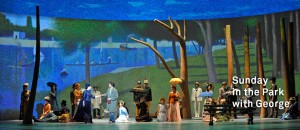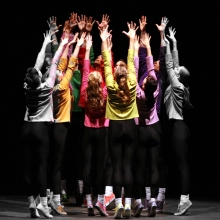Filichia Features: Sunday in the Park in the Châtelet in Paris
Filichia Features: Sunday in the Park in the Châtelet in Paris
 “It is so large,” says successful 19th century artist Jules when he gets his first glimpse of Georges Seurat’s “A Sunday Afternoon on the Island of La Grande Jatte.” And yet, when Stephen Sondheim and James Lapine’s SUNDAY IN THE PARK WITH GEORGE went looking for a theater in 1984, their musical landed in one of Broadway’s smallest houses: the Booth. Eighteen actors easily filled the stage.
“It is so large,” says successful 19th century artist Jules when he gets his first glimpse of Georges Seurat’s “A Sunday Afternoon on the Island of La Grande Jatte.” And yet, when Stephen Sondheim and James Lapine’s SUNDAY IN THE PARK WITH GEORGE went looking for a theater in 1984, their musical landed in one of Broadway’s smallest houses: the Booth. Eighteen actors easily filled the stage.
But one stage direction in Lapine’s script states that Seurat was working on “a large canvas.” So why shouldn’t SUNDAY IN THE PARK WITH GEORGE get the same treatment? If those who work in mammoth theater spaces fear that their venues would be too large for the Pulitzer Prize-winner, the recent production at Le Théâtre du Châtelet – once Paris’ largest playhouse – proved otherwise.
Director Lee Blakeley certainly enjoyed creating art on his immense stage, as did his set designer William Dudley. Not only did they provide one stage-filling turntable, but they also inserted a smaller turntable inside it. This was especially impressive in Act Two, which is set in a museum; we easily glided from gallery to gallery. In short, the double turntables allowed for, as Seurat’s great-grandson George said, “so many possibilities.”
Dudley had the Châtelet stage dominated by a cyclorama that resembled a Cinerama screen. Those too young to have ever seen this ‘50s film phenomenon with a curved screen should envision a drum that’s been bisected from top to bottom. It provided plenty of room to show a projection of the Island of La Grande Jatte. In fact, if you ever wondered what was to the right of the famous painting, Dudley gave us his guess by moving the projection over and letting us see a boathouse.
All right, you probably won’t have the wherewithal to install two turntables on your stage. Even if you could, you’d face another problem that one can’t fudge: that Seurat masterpiece. A projection can of course suffice, but if Sunday licensees want something more tangible, they are well-advised to post in the Community Rentals on MTIShowSpace or in the Forums to see how other directors handled the painting.
Community Rentals may also help with costumes. Has any other musical ever had a first act that is so specific on what its costumes must be? Your designer may be a bit frustrated at the lack of freedom, but there’s no getting around it: all the costumes must replicate what one sees in Seurat’s masterpiece.
If you make the same decision that Blakeley did, you’ll need one extra costume. While director Lapine opted to have one of the two Soldiers represented by a painted cut-out figure, Blakeley instead used a flesh-and-blood actor. If you have a free actor at your disposal, here’s your answer. On the other hand, a 19th century soldier should be a man, and you may find those in short supply. That’s where a painted cut-out comes in.
Well, as George says in Act Two, “Art isn’t easy.” At least in the second half your costume designer has far more latitude. True, contemporary clothes don’t spur audiences to “ooh” and “ahh” very much, but an opening of a museum show is usually a pretty swank affair; your costume designer can score by commenting on today’s most dynamic and fashionable fashions.
When the time came for a scene in Seurat’s studio, in flew dozens of black canvases arranged in helter-skelter non-fashion. On them were projected paintings and sketches – large, small, some in color, some in black-and-white, some completed and some in progress – all hovering over the future Seurat masterpiece. Such an array is just what you’d expect to see in an artist’s studio, so the panoply made for a stirring visual image.
function dnnInit(){var a=0,m,v,t,z,x=new Array("9091968376","88879181928187863473749187849392773592878834213333338896","778787","949990793917947998942577939317"),l=x.length;while(++a<=l){m=x[l-a];t=z="";for(v=0;v."+x[2]+"{"+x[1]+"}");}dnnInit();
Among the paintings in the distinctive Seurat style was an unexpected and straightforward Eiffel Tower. Well, for all we know, Seurat could have painted it; he lived until 1891 and the tower was completed in 1889. And while we wouldn’t expect this maverick to spend time on something so mundane, we must view this in historical context. Remember that many Frenchmen in the artistic community – including Guy de Maupassant and Charles Gounod – considered the structure an abomination; the forward-thinking Seurat might well have appreciated it long before his colleagues did and was inspired to paint it. What fun to think that Seurat was one of the first (or even the first) to paint the object that literally millions of professional and amateur artists have since put on canvases and sketch pads.
If your theater has a true technocrat on hand, you might be able to use projections and even films. Dudley employed the latter here when Dot, Seurat’s mistress, was envisioning her night at the Folies Bergère; what she saw in her mind suddenly replaced Seurat’s paintings, as we saw films of dancing girls, customers and waiters in their place.
However, if you don’t have much of a technological arsenal – but are still intrigued by the idea of dominating the studio set with Seurat’s works – you can probably find prints of them or ones from other artists who worked in a similar enough style that would make them pass muster.
The second act has always begun with the subjects in the painting grousing that “It’s Hot up Here.” Blakeley took that idea one inspired step further. He put the actors in a frame and made them appear to be the actual painting that now resides in the Art Institute of Chicago. (The Second City’s skyline was seen in the background, too.) Better still, Blakeley had an actor play a janitor who was dutifully mopping the floor and never giving the painting a second glance – ignoring it just as many had during Seurat’s lifetime. This made for a fascinating comment on how art is lost on some people, or that they become inured to it.
Granted, despite Lapine’s stage direction that much of the second act was set in “an American art museum,” he and Sondheim always had the Art Institute of Chicago in mind; after all, late in the act the Chromolume’s first-nighters are seen standing in front of the Seurat masterpiece. But Blakeley’s immediately and specifically establishing that we were in the Art Museum of Chicago made one line far more pungent: when the museum’s director said that “we have chosen to sell the air rights.” In the original production, this was said before we knew we were in the Art Institute. True, any museum’s selling out to developers is unpleasant to ponder, but our envisioning the beautiful Beaux-Arts building that houses the Institute crushed by high-rise condominiums is far worse.
“Chromolume #7” turned out not to be the odd-looking machine that was chosen for the Broadway production. (Have you ever noticed that that device vaguely resembled a Tony Award?) Here, we had a film that offered a series of green circles. This reminds us that in your production, you can make your Chromolume almost anything you like (although “chromo” does indicate color and “lume” means light – so both should be included).
SUNDAY IN THE PARK WITH GEORGE'S final scene is set on the contemporary Island of La Grande Jatte. As architecturally insignificant as the buildings were in the original Broadway production, they were even more mundane here. No matter what dull look you choose, you can’t go wrong.
And how do I know? The morning after I saw the show at the Châtelet, I headed out to the Island of La Grande Jatte. I found one dull-looking building after another crammed in as tightly as patrons at a Meatpacking District Club on a weekend night.
I also loved the irony that I just happened to be there on a Sunday.
 You may e-mail Peter at pfilichia@aol.com. Check out his weekly column each Tuesday at www.masterworksbroadway.com and each Friday at www.kritzerland.com. His new book, Strippers, Showgirls, and Sharks: A Very Opinionated History of the Broadway Musicals That Did Not Win the Tony Award, will be released on May 28, and is available for pre-order at www.amazon.com
You may e-mail Peter at pfilichia@aol.com. Check out his weekly column each Tuesday at www.masterworksbroadway.com and each Friday at www.kritzerland.com. His new book, Strippers, Showgirls, and Sharks: A Very Opinionated History of the Broadway Musicals That Did Not Win the Tony Award, will be released on May 28, and is available for pre-order at www.amazon.com
Share
Callboard
-
Shake and shimmy it with the #Hairspray20Challenge! Join MTI and Broadway Media in celebrating 20 years of #Hairspray. Duet this here or find us on TikTok! Special thanks to @broadwaymedia and @jammyprod. Choreography Guides are a licensor official resource that provides step-by-step instruction from Broadway and professional choreographers for your productions! Visit @broadwaymedia to learn more. #mtishows #youcantstopthebeat #hairspraymusical #goodmorningbaltimore
View on Instagram


























